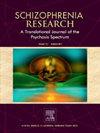The mediating influence of serum Klotho levels and the KL-VS heterozygosity on telomere shortening in schizophrenia
IF 3.5
2区 医学
Q1 PSYCHIATRY
引用次数: 0
Abstract
Schizophrenia (SZ) has a considerable contribution of accelerated aging, and exploration of the mechanistic underpinnings of telomere attrition, one of the core pathophysiological hallmarks of accelerated aging could boost the development of new avenues for intervention in SZ. The longevity protein Klotho (KL) is reported to regulate the expression of key factors like telomeric repeat-binding factor. We tested the cross-sectional association between KL levels, its longevity genetic variant KL-VS and telomere length in schizophrenia, including 240 patients and 243 healthy controls (HCs). Relative telomere length (rTL) was measured through real-time polymerase chain reaction, and the KL-VS variant was genotyped using TaqMan® allelic discrimination assay. The associations between study variables were tested using linear regression, and mediation analysis was conducted using the SPSS Macro PROCESS. There was a significant association between rTL with serum KL levels in chronic patients, indicating their coregulation in the disease. KL levels partly mediated the indirect negative influence of telomere length on the risk of schizophrenia, with a 27.26 % contribution to the total association between telomere length and schizophrenia, substantiating the role of deficiency of circulating Klotho in partly contributing to the process of accelerated aging in schizophrenia. Furthermore, serum KL levels and heterozygosity of the KL-VS variant (Het+ve) were significantly and positively associated with rTL in patients with SZ, but not in HCs, indicating a disease-specific influence of the KL on telomere length, which supports the hypothesis of a contextual advantage.
血清Klotho水平和KL-VS杂合性对精神分裂症患者端粒缩短的中介作用
精神分裂症(SZ)对加速衰老有相当大的贡献,探索端粒磨损的机制基础,端粒磨损是加速衰老的核心病理生理标志之一,可以促进SZ干预新途径的发展。据报道,长寿蛋白Klotho (KL)可调节端粒重复结合因子等关键因子的表达。我们测试了精神分裂症患者KL水平、其长寿遗传变异KL- vs和端粒长度之间的横断面关联,包括240名患者和243名健康对照(hc)。实时聚合酶链反应测定相对端粒长度(rTL), TaqMan等位基因鉴别法对KL-VS变异进行基因分型。采用线性回归检验研究变量之间的相关性,采用SPSS Macro PROCESS进行中介分析。慢性患者rTL与血清KL水平之间存在显著相关性,表明两者在疾病中的协同调节作用。KL水平在一定程度上介导了端粒长度对精神分裂症风险的间接负面影响,在端粒长度与精神分裂症之间的总关联中贡献了27.26%,证实了循环Klotho缺乏在精神分裂症加速衰老过程中的部分作用。此外,血清KL水平和KL- vs变异(Het+ve)的杂合度与SZ患者的rTL呈显著正相关,但在hc患者中没有,这表明KL对端粒长度有疾病特异性影响,这支持了上下文优势的假设。
本文章由计算机程序翻译,如有差异,请以英文原文为准。
求助全文
约1分钟内获得全文
求助全文
来源期刊

Schizophrenia Research
医学-精神病学
CiteScore
7.50
自引率
8.90%
发文量
429
审稿时长
10.2 weeks
期刊介绍:
As official journal of the Schizophrenia International Research Society (SIRS) Schizophrenia Research is THE journal of choice for international researchers and clinicians to share their work with the global schizophrenia research community. More than 6000 institutes have online or print (or both) access to this journal - the largest specialist journal in the field, with the largest readership!
Schizophrenia Research''s time to first decision is as fast as 6 weeks and its publishing speed is as fast as 4 weeks until online publication (corrected proof/Article in Press) after acceptance and 14 weeks from acceptance until publication in a printed issue.
The journal publishes novel papers that really contribute to understanding the biology and treatment of schizophrenic disorders; Schizophrenia Research brings together biological, clinical and psychological research in order to stimulate the synthesis of findings from all disciplines involved in improving patient outcomes in schizophrenia.
 求助内容:
求助内容: 应助结果提醒方式:
应助结果提醒方式:


